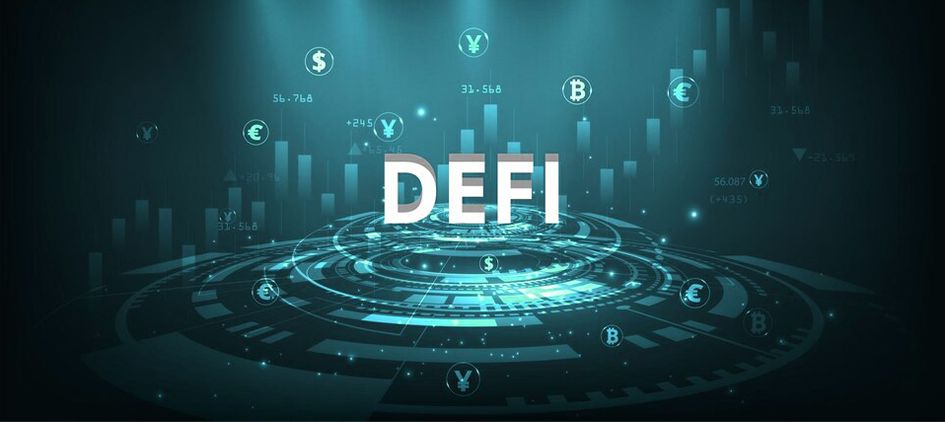
Decentralized Finance (DeFi): Exploring the Potential Disruption to Traditional Banking
Decentralized Finance (DeFi) is a rapidly growing sector of the cryptocurrency and blockchain industry that is on the brink of revolutionizing traditional financial systems by promoting innovation and modernization. It presents an all-encompassing financial system that is accessible to individuals worldwide, irrespective of their ethnicity, origin, or geographical location, thereby challenging the longstanding dominance of centralized banks regulated by governments.
The objective of this article is to offer a thorough examination of the current DeFi landscape, including its historical development, significant contributions, and applications. Furthermore, it investigates the inherent potential of DeFi and the obstacles that hinder its widespread societal adoption. This matter is especially relevant due to skepticism towards DeFi. The coexistence of traditional banking and decentralized finance (DeFi) is paramount in the future development of financial services. The emergence of DeFi represents a fundamental shift toward decentralized and borderless financial ecosystems, which challenges the centralized nature of Traditional Banking systems.
Traditional banking has been instrumental in financial transactions for a long time, as it has a well-established infrastructure and regulatory framework that ensure stability and trust for both individuals and businesses. Nevertheless, it is constrained by high fees, geographical restrictions, and lengthy transaction processes, increasing the demand for more efficient alternatives such as DeFi. The dynamic interplay between DeFi’s innovation and Traditional Banking’s infrastructure introduces opportunities for collaboration, convergence, or potential collision.

Core Principles and Definition of DeFi
Decentralized Finance (DeFi) aims to revolutionize traditional financial services by eliminating intermediaries and facilitating direct peer-to-peer transactions. This transformative financial ecosystem is based on blockchain technology. Openness, transparency, and accessibility are the fundamental principles of DeFi. Users can independently verify transactions and contracts, as DeFi protocols operate on public blockchains, ensuring complete transparency.
Additionally, DeFi platforms are open-source, which encourages community-driven innovation and collaborative development. Developers are enabled to generate novel financial instruments and decentralized applications (DApps) that can seamlessly incorporate into the DeFi ecosystem, thereby increasing its functionality and diversity due to this open nature. DeFi also prioritizes financial inclusivity, ensuring that individuals worldwide can access financial services regardless of traditional credit or identification requirements. This dedication extends to underbanked and unbanked populations, bridging the gap between conventional banking systems and those denied access to formal financial services.
Users are guaranteed to retain ownership of their assets due to the decentralized nature of DeFi platforms. Users maintain their private keys and access financial services directly through non-custodial wallets rather than relying on a central authority to manage funds. This control improves security by reducing the likelihood of breaches or the mismanagement of funds through third-party intermediaries. DeFi’s fundamental principles are decentralization, transparency, accessibility, and financial inclusivity. DeFi’s potential to disrupt traditional banking and shape the future of finance is increasing rapidly.
 Key Elements of the DeFi Ecosystem
Key Elements of the DeFi Ecosystem
The financial services landscape is collectively redefined by a diverse array of interconnected components that comprise the DeFi ecosystem. These components introduce decentralization and transparency to traditional finance by operating on blockchain technology powered by smart contracts. Decentralized Exchanges (DEXs) enable direct peer-to-peer trading of digital assets without intermediaries, which are essential to the DeFi landscape. DEXs automated trading processes and guarantees secure custody through smart contracts, which gives users increased control over their assets.
Another essential component of DeFi is the decentralized lending and borrowing protocols. These protocols allow individuals to lend or borrow digital assets. Smart contracts, which regulate lending terms and automate collateral management, revolutionize credit markets, and enhance financial inclusion.
Automated Market Makers (AMMs) are essential for preserving liquidity in DeFi platforms. These algorithmic systems autonomously establish asset prices by analyzing supply and demand, motivating users to contribute liquidity to decentralized pools. Stablecoins, which are algorithmically stabilized or pegged to real-world assets, are designed to mitigate the volatility of cryptocurrencies. Stablecoins stabilizes a volatile market as a conduit between traditional financial systems and the digital world. DeFi’s infrastructure is further fortified by its dependence on decentralized identity solutions and oracles. Decentralized identity technologies enable users to manage their confidential information, thereby enhancing the privacy of transactions. Oracles function as data sources, enabling smart contracts to interact with external details precisely.
Furthermore, the DeFi ecosystem has increased the popularity of liquidity mining and yield farming. These mechanisms incentivize users to contribute liquidity to various DeFi platforms, resulting in rewards. These strategies improve the distribution of tokens and user engagement. The collaboration between these components fosters a dynamic DeFi ecosystem that revolutionizes financial services, thereby introducing a new era of decentralized finance.
 Benefits and Obstacles of DeFi
Benefits and Obstacles of DeFi
The emergence of Decentralized Finance (DeFi) has transformed the financial sector, which has introduced a transformative paradigm. This paradigm has brought with it both significant challenges and distinct advantages. DeFi demonstrates its capacity to promote financial inclusion globally in terms of its benefits. DeFi platforms provide financial services to previously marginalized individuals, allowing them to trade, borrow, and lend. This is consistent with the overarching objective of improving financial access and empowering underprivileged communities. The elimination of intermediaries from financial transactions is a fundamental benefit of DeFi. Implementing smart contracts eliminates the necessity for intermediaries, thereby expediting processes and reducing costs. This simplified method improves the efficiency and accessibility of financial services, granting consumers more control over their funds. Transparency and openness are inherent advantages of the DeFi ecosystem. DeFi transactions are recorded on an immutable ledger accessible to all participants through public blockchains. This transparency can potentially address non-compliance and fraud concerns and foster trust.
Nevertheless, DeFi is affected by obstacles. The security of smart contracts continues to be a significant issue. Past incidents have underscored the potential for substantial financial losses resulting from smart contract vulnerabilities. To mitigate these risks and improve the security of DeFi platforms, it is essential to implement rigorous auditing and coding practices. Another substantial obstacle is the complex web of regulatory uncertainty. The decentralized nature of DeFi frequently conflicts with conventional regulatory frameworks, leading to legal complexities and ambiguity. Maintaining a balance between innovation and compliance is essential to guarantee sustainable development. Scalability continues to represent an ongoing obstacle to the widespread adoption of DeFi. Slow transaction processing and exorbitant fees may result from high network congestion on prominent blockchains. Two–layer scaling is recommended as a potential solution to these constraints and to facilitate the expansion of the broader DeFi ecosystem.

Traditional Banking System Overview
The dynamic landscape of decentralized finance (DeFi) contrasts sharply with the traditional banking system, a longstanding pillar of the global financial framework. The origins of modern banks can be traced back to ancient civilizations, where rudimentary institutions were established to facilitate the storage and lending of currency. These initial concepts have since developed into intricate financial institutions essential for allocating capital, wealth management, and economic development. The traditional banking system is responsible for various crucial functions within economies.
Traditional banks are essential to the functioning of economies, as they serve as the foundation of financial systems and facilitate various functions critical to individuals, businesses, and governments. Deposit-takers are essential to the operation of traditional banks, as they offer a secure means for individuals and companies to store their funds. Banks utilize these funds to finance loans and investments, while depositors receive interest on their deposits. The involvement of traditional banks as intermediaries in the credit market is equally critical.
By evaluating consumers ‘ creditworthiness, they provide loans for various purposes, including personal requirements and entrepreneurial ventures. This intermediary function promotes economic development by ensuring the efficient allocation of capital. Traditional banks offer essential payment and settlement services, facilitating the smooth execution of financial transactions. These services are the foundation of economic interactions, enabling individuals and businesses to transmit funds domestically and across borders.
In addition to these functions, traditional banks engage in wealth management activities, offering clients various financial services, including investment advisory, retirement planning, and portfolio management, to meet individuals’ long-term financial objectives and aspirations. Traditional banks serve as intermediaries, facilitating the exchange of funds between borrowers and savers. Their responsibilities in financial intermediation include the assessment of risk, the establishment of interest rates, and the allocation of capital to a variety of sectors, thereby fostering economic stability and growth. Traditional banks are regulated to ensure financial stability and defend the interests of their clients by mandating capital adequacy, risk management, and consumer protection.

Advantages and Disadvantages of Traditional Banking in the Digital Era
Traditional banks are currently confronted with various advantages and challenges due to the changing technological landscape in the digital age. The physical presence of brick-and-mortar branches in the digital age is one of the notable advantages of traditional banking, as it allows customers to engage in personal interactions and conduct face-to-face transactions. Traditional banks have developed a reputation for reliability and trustworthiness, which is reassuring to customers who prioritize stability and security, particularly when discussing sensitive financial matters. In addition, conventional banks provide a wide range of financial services under a single roof, addressing a wide range of financial requirements, including mortgages, investment advice, and checking accounts.
Brick-and-mortar banks have restricted operational hours, which can be inconvenient if you require banking services outside of business hours. You may be required to wait in line during peak hours, and certain transactions may necessitate appointments.
Nevertheless, the digital era also presents challenges for traditional banks, such as the digital divide, which restricts the availability of online banking services to specific demographics. The emergence of fintech and digital banking solutions has created a competitive environment that traditional banks must navigate, potentially leading tech-savvy customers to alternative platforms.

Convergence between Traditional Banking and DeFi
Traditional banking and Decentralized Finance (DeFi) share various objectives and overlapping features. Although they differ in their operational mechanisms, these two financial paradigms share common goals within the broader economic ecosystem: they converge in specific areas. DeFi and traditional banking systems both aim for financial inclusion. DeFi endeavors to expand financial access globally through blockchain technology and decentralized networks, while conventional banking seeks to provide access to financial services for underserved and unbanked populations.
Additionally, the efficacy of transactions is a common thread that unites traditional banking and DeFi. DeFi platforms capitalize on the speed and transparency of blockchain technology to optimize transaction efficiency, while conventional banks prioritize the efficient processing of payments and fund transfers. Security and trust are additional objectives that are shared. To safeguard client data and transactions, conventional banks implement security protocols. Likewise, DeFi platforms emphasize the importance of secure smart contracts and decentralized protocols to guarantee data integrity and users’ trust. Both systems prioritize risk management. Traditionally, banks implement risk assessment and mitigation strategies for their loan portfolios, whereas DeFi platforms incorporate risk management protocols to protect assets and reduce vulnerabilities.
Innovation and adaptation are mutual objectives. Decentralized financial services are continuously improved by DeFi platforms, which perpetually innovate, while traditional banking institutions strive to integrate technology to enhance customer experiences. DeFi and traditional banking share common objectives, including financial inclusion, transaction efficiency, security, risk management, and innovation, despite their executional differences.

Potential Advantages of Interoperability and Collaboration
The potential benefits of the convergence of Decentralized Finance (DeFi) and conventional banking systems are promising, driven by collaboration and interoperability between these distinct financial realms. These advantages emphasize the potential collaborations that can be achieved by combining the strengths of each system.

Enhanced Financial Inclusion
Collaboration between traditional banking and DeFi can enhance efforts to promote financial inclusion. Traditional banks can provide the infrastructure and accessibility necessary for a broader reach, while DeFi’s decentralized nature can extend financial services to populations traditionally underserved by conventional banking.

Efficient Cross-Border Transactions
Integrating DeFi and traditional banking can result in more efficient cross-border transactions using blockchain technology. Blockchain networks’ inherent transparency and speed can simplify the complexities and times associated with international money transfers.

A Wide Range of Financial Services
The partnership has the potential to produce a harmonious combination of comprehensive financial services. Traditional institutions can provide diverse financial products, further enhanced by DeFi’s ability to customize solutions. This collaboration offers consumers an extensive array of alternatives customized to their unique economic, political, and regional development circumstances.

Technological Progress and Innovation
Convergence has the potential to stimulate technological advancement and innovation. DeFi’s agile and experimental nature could motivate traditional institutions to adopt modern technologies and improve their offerings. In contrast, conventional banks’ infrastructure can serve as a reliable foundation for DeFi initiatives that aspire to mainstream adoption and scalability.
Conclusion
The integration of DeFi and traditional banking demands collaboration, a clear interpretation of decentralized technologies within legal frameworks, and an adjustment of regulatory standards. The future relationship between these two domains is fundamentally influenced by the ability to balance innovation and consumer protection. Predictions for the future indicate that collaboration will increase, emphasizing the optimal balance of innovation and Economics, Politics, and Regional Development. This transformative paradigm shift necessitates regulatory compliance.
How Can Datavision help?
We assist various financial institutions and global banks on their digital transformation journey. Our one-of-a-kind approach, which combines people, process, and technology, expedites the delivery of superior results to our clients and drives excellence. Several reputed companies leverage our proprietary suite of business excellence tools and services to unlock new growth levers and unparalleled ROI.
Datavision stands proudly as a prominent banking software solutions provider, recognized for our unwavering commitment to excellence in the industry. We have earned our esteemed reputation by consistently delivering cutting-edge core banking software, catering to the needs of both retail and corporate banking software sectors. At Datavision, our mission is clear: to provide our clients with the best banking software products, ensuring that they stay ahead in an ever-evolving financial landscape. We take pride in serving our prestigious clients and look forward to continuing our journey of innovation and excellence.
Our portfolio of banking software product and services include:
Core Banking Solutions: | FinNext Core | Banking: | FinTrade | EasyLoan | MicroFin |
Digital Banking Solutions: | IBanc | MobiBanc | MBranch | FinTab | FinSight |
Risk & Compliance: |FinTrust |
Want to know how our team of experts at Datavision provides customizable, scalable, and cost-effective banking software products and solutions to our esteemed clients? Visit us for more information.